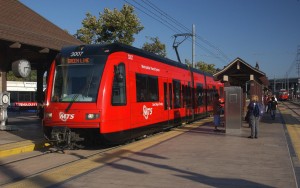 In the rail station area grades we released last week, two regions finished at the bottom of the heap in encouraging smart growth: Santa Clara and San Diego. I have to admit, I have not heard much of a response from people in the San Jose/Santa Clara area, which is surprising given how much the Bay Area prides itself on transit and connectivity.
In the rail station area grades we released last week, two regions finished at the bottom of the heap in encouraging smart growth: Santa Clara and San Diego. I have to admit, I have not heard much of a response from people in the San Jose/Santa Clara area, which is surprising given how much the Bay Area prides itself on transit and connectivity.
But in San Diego, there’s been much coverage of the results (see my San Diego Union-Tribune op-ed in response, co-authored with Next 10’s F. Noel Perry, here). Unfortunately, much of it has been directed at San Diego MTS, as I blogged about last week. But Voice of San Diego grasped the implications of the low grades:
The study’s most critical conclusions weren’t directed at the Metropolitan Transit System or its stations. They keyed on decades of development decisions by the city of San Diego and other cities along the trolley lines.
It quantified a phenomenon that’s long been apparent anecdotally: Local leaders support smart growth – urban development that’s crucial for transit ridership – in theory, but not in practice.
They are not planning for or facilitating enough construction of walkable, affordable housing near transit access points.
Writer Andrew Keatts gives some specific examples of where local policies have thwarted transit-oriented development:
Last year, for instance, San Diego’s planning department released a study recommending the city increase the amount of development allowed at two new trolley stops planned as part of a $1.7 billion light-rail extension from Old Town to University City.
Residents revolted. They demanded the city not increase the 30-foot limit on new buildings near the station proposed for Clairemont Drive, or increase the number of homes that could be built in the area.
Mayor Kevin Faulconer quickly directed city staff to announce it wouldn’t raise the height limit.
I’m glad to see reporting on these kinds of instances, because these local decisions more than anything else determine the low scores of the station areas in places like San Diego. It will take some combination of public pressure and regulatory and financial incentives to overcome this dynamic.
Leave a Reply
You must be logged in to post a comment.


